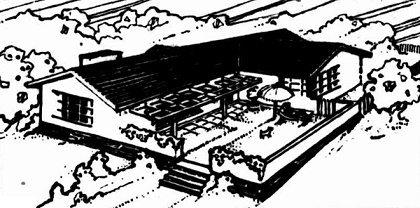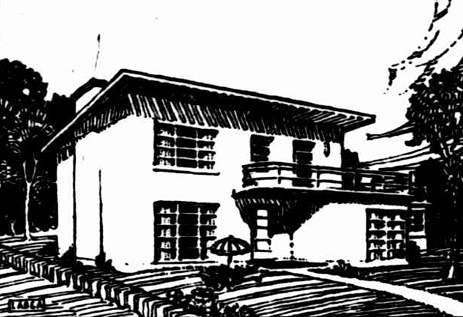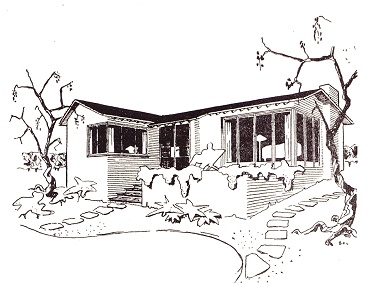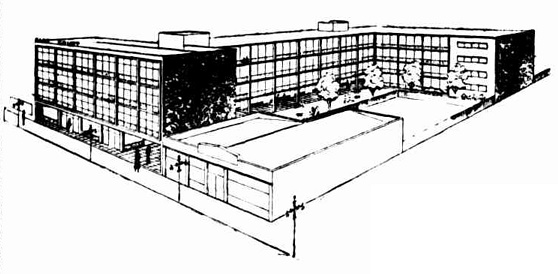Charles Mervyn John Morgan was born
in Fremantle, Western Australia, on 21 July 1916. From birth, he was known by his second name in order to distinguish himself from his like-named father, Corporal
Charles Henry Morgan. During the First World War, the elder
Morgan served with
the 11th Batallion in France and, tragically, was killed in
action at Posieres only four days after his son's birth. Mervyn's
widowed mother, Alice, later remarried, becoming Mrs George Deary.
Morgan commenced his career as an articled pupil of leading Perth architect William Garnsworthy Bennett (1896-1977). Although he completed his junior and leaving certificates at the University of WA, an architecture course had not yet been established there, prompting him to relocate to Melbourne. Arriving in early 1937, he commenced the Diploma of Architecture at Melbourne Technical College (now RMIT) and attended evening classes at the Melbourne University Architectural Atelier. During the day, Morgan worked as a draftsman, initially with Leighton Irwin and later in the office then known as Yuncken, Freeman Brothers & Griffith. During his time in Irwin's practice, he befriended Robin Boyd, who was then working for A & K Henderson. The two young men became secretary and committee member, respectively, of the VASS, in which capacity they were instructed by the president, Roy Simpson, to co-produce a student newspaper. The first issue of Smudges, as it was titled, appeared in May 1939. With Morgan credited as 'business manager' and Boyd as editor and principal contributor, the notorious and popular broadsheet marked the start of the latter's career in incisive architectural criticism.
During 1940, Morgan became registered as an architect in Victoria and spent three months as a draftsman in the office of mechanical engineer W E Bassett. The following year, he became engaged to Miss Verna Jackson of South Yarra; the couple married in February 1942 (in one newspaper announcement, the groom was identified as C Mervyn Morgan-Deary, acknowledging the surname of his stepfather). Six months after the wedding, Morgan followed in the footsteps of his late father and enlisted with the Australian Army. He served with the 51st Australian Field Park Company and was discharged in early 1946 with the rank of Captain.
Morgan's earliest known foray into private practice dates from July 1946, when he called tenders for a renovation project in Deniliquin, NSW. By the following year, he had formally established himself in Melbourne with a city office at 473 Bourke Street. Soon afterwards, he entered into partnership with atelier classmate and fellow ex-serviceman Douglas Norman. London-born Norman (1919-1988) had served with the RAAF from 1940 to 1945 and was mentioned in dispatches 'for valuable services in the North-Eastern area'. After the war, Norman briefly worked for Yuncken, Freeman Brothers, Griffiths & Simpson before joining Morgan in partnership around 1948. During these early years, the practice focused largely on residential work and is known to have been involved in the design and construction of war service houses. Morgan's office evidently also undertook some retail projects, as it is recorded that he embarked upon a trip to England in April 1950 to study cafe design. His partnership with Doug Norman was formally dissolved at the end of that year, whereupon Morgan re-established practice under his own name, from the same address.
In the early 1950s, Morgan became increasingly interested in town planning and enrolled in the recently-established postgraduate course at the University of Melbourne. In July 1952, he travelled overseas to represent the Town & Country Planning Association of Victoria at an international town planning congress in Amsterdam. Two months after his return, he was one of the first 21 people to be conferred with the new Diploma of Town & Regional Planning. Subsequently, he styled his private practice as C Mervyn Morgan & Associates, architects and town planners. His output in the 1950s was broad, and included houses, office buildings and industrial projects. He also maintained his early association with the NSW Riverina, undertaking further work in Jerilderie, Deniliquin and environs. In 1960-61, Morgan briefly employed a young Peter Corrigan, providing him with his earliest experience in an architectural office.
A resident of Toorak for more than two decades, Morgan lived in a house of his own design in Duffryn Place, off Torresdale Road. He died on 6 July 1989.
Morgan commenced his career as an articled pupil of leading Perth architect William Garnsworthy Bennett (1896-1977). Although he completed his junior and leaving certificates at the University of WA, an architecture course had not yet been established there, prompting him to relocate to Melbourne. Arriving in early 1937, he commenced the Diploma of Architecture at Melbourne Technical College (now RMIT) and attended evening classes at the Melbourne University Architectural Atelier. During the day, Morgan worked as a draftsman, initially with Leighton Irwin and later in the office then known as Yuncken, Freeman Brothers & Griffith. During his time in Irwin's practice, he befriended Robin Boyd, who was then working for A & K Henderson. The two young men became secretary and committee member, respectively, of the VASS, in which capacity they were instructed by the president, Roy Simpson, to co-produce a student newspaper. The first issue of Smudges, as it was titled, appeared in May 1939. With Morgan credited as 'business manager' and Boyd as editor and principal contributor, the notorious and popular broadsheet marked the start of the latter's career in incisive architectural criticism.
During 1940, Morgan became registered as an architect in Victoria and spent three months as a draftsman in the office of mechanical engineer W E Bassett. The following year, he became engaged to Miss Verna Jackson of South Yarra; the couple married in February 1942 (in one newspaper announcement, the groom was identified as C Mervyn Morgan-Deary, acknowledging the surname of his stepfather). Six months after the wedding, Morgan followed in the footsteps of his late father and enlisted with the Australian Army. He served with the 51st Australian Field Park Company and was discharged in early 1946 with the rank of Captain.
Morgan's earliest known foray into private practice dates from July 1946, when he called tenders for a renovation project in Deniliquin, NSW. By the following year, he had formally established himself in Melbourne with a city office at 473 Bourke Street. Soon afterwards, he entered into partnership with atelier classmate and fellow ex-serviceman Douglas Norman. London-born Norman (1919-1988) had served with the RAAF from 1940 to 1945 and was mentioned in dispatches 'for valuable services in the North-Eastern area'. After the war, Norman briefly worked for Yuncken, Freeman Brothers, Griffiths & Simpson before joining Morgan in partnership around 1948. During these early years, the practice focused largely on residential work and is known to have been involved in the design and construction of war service houses. Morgan's office evidently also undertook some retail projects, as it is recorded that he embarked upon a trip to England in April 1950 to study cafe design. His partnership with Doug Norman was formally dissolved at the end of that year, whereupon Morgan re-established practice under his own name, from the same address.
In the early 1950s, Morgan became increasingly interested in town planning and enrolled in the recently-established postgraduate course at the University of Melbourne. In July 1952, he travelled overseas to represent the Town & Country Planning Association of Victoria at an international town planning congress in Amsterdam. Two months after his return, he was one of the first 21 people to be conferred with the new Diploma of Town & Regional Planning. Subsequently, he styled his private practice as C Mervyn Morgan & Associates, architects and town planners. His output in the 1950s was broad, and included houses, office buildings and industrial projects. He also maintained his early association with the NSW Riverina, undertaking further work in Jerilderie, Deniliquin and environs. In 1960-61, Morgan briefly employed a young Peter Corrigan, providing him with his earliest experience in an architectural office.
A resident of Toorak for more than two decades, Morgan lived in a house of his own design in Duffryn Place, off Torresdale Road. He died on 6 July 1989.
Select List of Projects
C Mervyn Morgan (1946-1948)
| 1946 1947 | Alterations and extensions to business premises, Deniliquin, NSW Residence, Port Nepean Road, Seaford Residence, Rosanna |
C Mervyn Morgan & D A Norman (1948-50)
| 1949 | Residence, Ringwood Residence, Mount Eliza |
C Mervyn Morgan & Associates (1951 onwards)
| 1952 1953 1954 1956 1957 1960 1961 1962 | Additions to factory for Belli Asbestos & Engineering, Waverley Road, Malvern East Residence, Daveys Bay Road, Mount Eliza Remodelling of office building (Oxford Chambers), Bourke Street, Melbourne Residence, Fernell Court, Toorak Office building (Park Court), Lonsdale Street, Dandenong Residence, Union Street, Templestowe Office building for Austin Ellerman & Associates, Jerilderie, NSW Residence, Duffryn Place, Toorak Caravilla Motel, McKillop Street, Geelong Office building (Milbourn House), Queen Street, Melbourne |
 | |
| Scheme for a house at Rosanna (1947) |
 | |
| Scheme for a house at Seaford (1947) |
 | |
| Scheme for a house at Mount Eliza (1949) |
 | |
| Scheme for an office complex at Dandenong (1956) |
top
